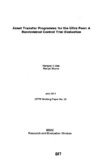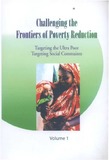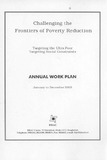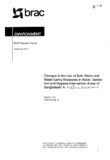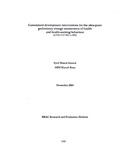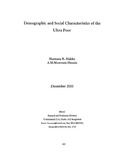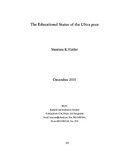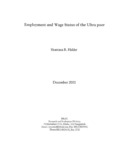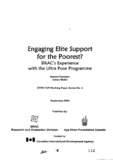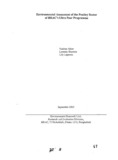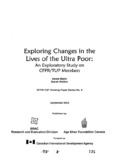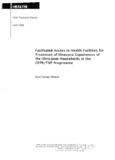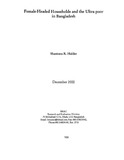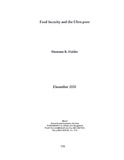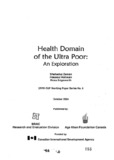Browsing by Subject "Ultra poor"
Now showing items 1-20 of 32
-
Asset transfer programme for the ultra poor: a randomized control trial evaluation
(BRAC, 2011-07)Challenging the Frontiers of Poverty Reduction (CFPR), an innovative approach to address extreme poverty, was launched in 2002 in rural Bangladesh. Evaluation of the first phase of the programme revealed that livelihoods ... -
Attitudes of the Elite Groups towards the ultra-poor: secondary stakeholders in the CFPR-TUP
(BRAC Research and Evaluation Division (RED), 2003)"Attitudes of the Elite Groups towards the Ultra-Poor Secondary stakeholders in the CFPR-TUP" was initiated as a combined effort between Advocacy and RED. Secondary stakeholders are those that beyond the primary stakeholders ... -
Changes in the use of safe water and water safety measures in water, sanitation and hygiene intervention areas of Bangladesh: a midline assessment
(BRAC Research and Evaluation Division (RED), 2011-11)The BRAC Water, Sanitation and Hygiene (WASH) programme reached 150 upazilas (sub-districts) in collaboration with the Government of Bangladesh since 2006. This study assessed the changes in the use of tubewell water and ... -
Changes in the use of safe water and water safety measures in water, sanitation and hygiene intervention areas of Bangladesh: a midline assessment
(BRAC Research and Evaluation Division (RED), 2010-12)The BRAC Water, Sanitation and Hygiene (WASH) programme reached 150 upazilas (sub-districts) in collaboration with the Government of Bangladesh since 2006. This study assessed the changes in the use of tubewell water and ... -
Customized development interventions for the ultra-poor: preliminary change assessments of health and health-seeking behaviour
(BRAC Research and Evaluation Division (RED), 2004-11) -
Demographic and social characteristics of the ultra poor
(Research and Evaluation Division, Brac, 2000-12)This report aimed to understand the demographic, social and economic characteristics of the ultra poor. Analysis of data clearly showed that the ultra poor households were smaller in size than the rural average. One-third ... -
The educational status of the ultra poor
(Research and Evaluation Division, Brac, 2000-12)This report describes the state of education of the ultra poor by considering four indicators namely: net enrollment rate of children between 6-10 years of age, adult and household literacy rates, educational status of ... -
Employment and wage status of the ultra poor
(Research and Evaluation Division, Brac, 2000-12)This report looked into the employment status of the ultra poor and factors affecting the extent of employment. Findings showed that 92% of the households were with economically active population. Majority of the rest ... -
Engaging elite support for the poorest? BRAC's experience with the ultra poor programme (TUP working paper -3)
(BRAC, 2004-09)This paper describes and draws lessons from the experience of engaging village elite in support of the ultra poor through the Gram Shahayak Committees (GSC), as part of BRAC's CFPR/TUP programme. The paper addresses the ... -
Environmental assessment of the poultry sector of BRAC's ultra poor programme
(BRAC Research and Evaluation Division (RED), 2003-09)This study aimed to conduct an environmental assessment of the poultry sector of 'Challenging the Frontiers of Poverty Reduction/ Targeting the Ultra Poor Program (CFPR!fUP)' program of BRAC. Special focus was given to ... -
Exploring changes in the lives of the ultra poor: an exploratory study on CFPR/TUP members
(BRAC, 2004-09)Since January 2002, BRAC has started a new experimental programme for the ultra poor called, 'Challenging the Frontiers of Poverty Reduction/Targeting the Ultra Poor' (CFPRffUP). This programme targets the ultra poor who ... -
Facilitated access to health facilities for treatment of illnesses experiences of the ultra poor households in the CFPR/TUP Programme
(BRAC Research and Evaluation Division (RED), 2006-04) -
Female-headed households and the ultra poor in Bangladesh
(Research and Evaluation Division, Brac, 2000-12)This report focuses on the magnitude of FHHs among the poorest and examines their socio-economic profile to highlight the distinction between FHHs and the entire sample. Female-headed households (FHHs) are of two types: ... -
Food security and the ultra poor
(Research and Evaluation Division, Brac, 2000-12)This paper aims to derive some policy guidelines by analysing factors affecting food security of the ultra poor. Here more emphasis is given on the number of rice meals taken and the sources of rice consumed during the ... -
Globalising Southern approaches to reducing extreme poverty: Policy adoption of BRAC’s targeting the ultra poor graduation program
(Taylor and Francis, 2024-03-30)This paper explores how BRAC’s Targeting the Ultra Poor graduation program was globally adopted as a successful pathway for extremely poor households to build sustainable livelihoods and improve their conditions. It explores ... -
Health domain of the ultra poor: an exploration
(BRAC, 2004-10)There has been an increasing amount of materials surrounding health-seeking behaviour in recent years. However, a relatively small proportion of literature has focused upon health behaviours and types of health services ... -
Income status of the ultra poor
(Research and Evaluation Division, Brac, 2000-12)This paper reports on income status, major sources of income and determinants of income of the ultra poor Mean per capita income was calculated to be Tk.3,385, per annum that was even less than the estimated lower poverty ...

